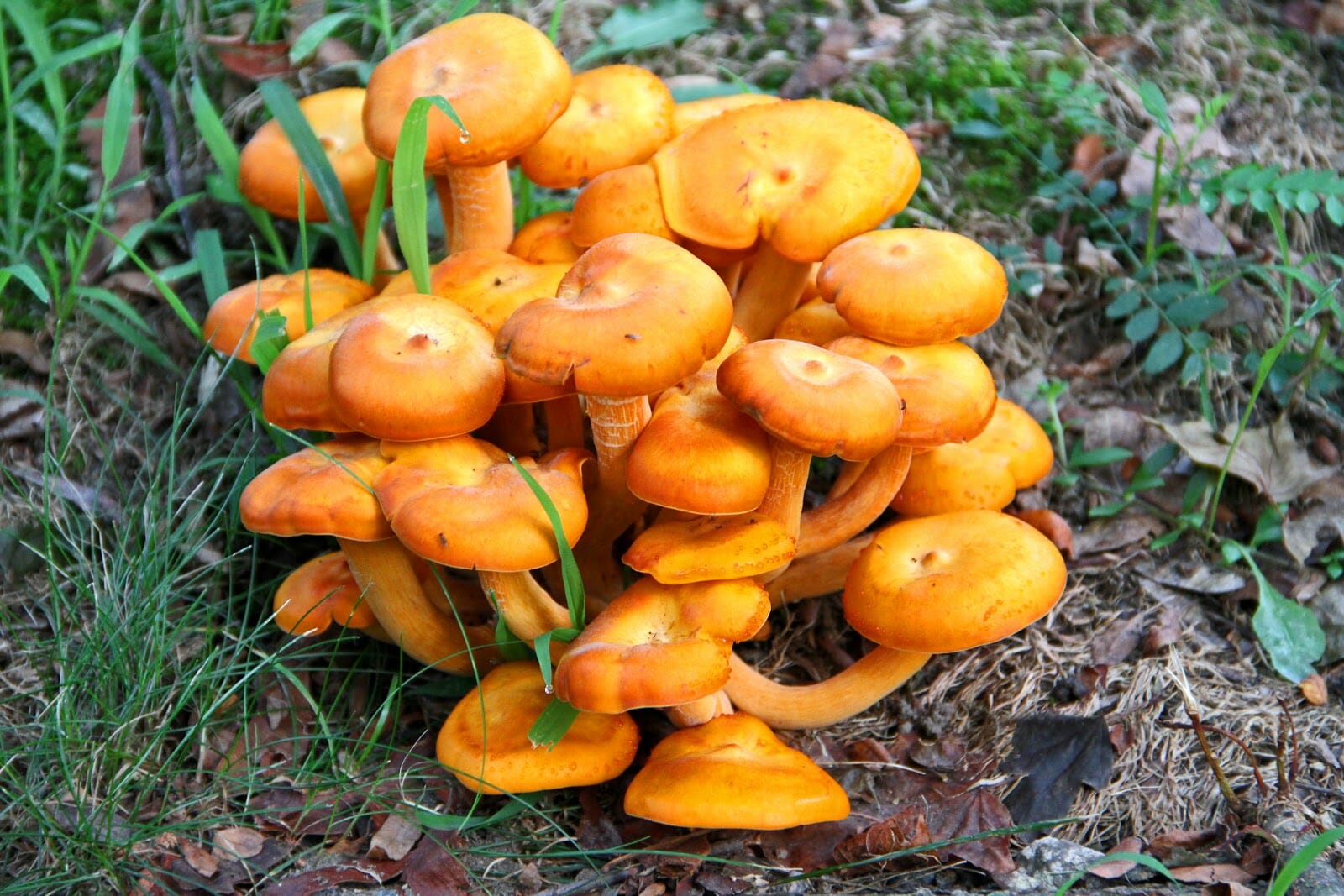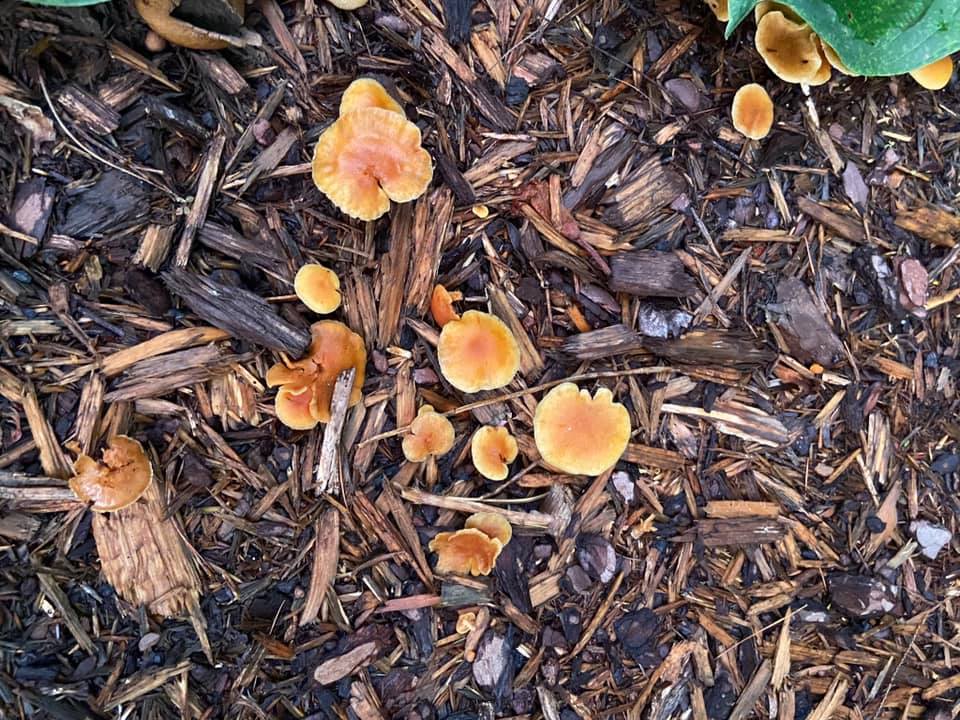While mushrooms make for a delicious delicacy many people around the world enjoy, not every mushroom is edible.
Therefore, you must be careful about touching or eating the mushroom you come across.
You will likely find different types of mushrooms growing on your lawn, including orange mushrooms.
Usually, orange mushrooms in yard signify a great garden, and it doesn’t hurt that they are beautiful.
Besides that, you probably want to know whether these orange mushrooms are toxic, especially if you have pets and small kids.
Keep reading for a detailed answer on the toxicity of orange mushrooms and everything else you need to know about these mushrooms.
What Are the Orange Mushrooms in Yard?
The orange mushrooms in a yard are likely Jack-o-lantern mushrooms (Omphalotus Olearius).
These mushrooms are fleshy and bright orange, growing in dense clusters on rotting wood, dead trees, and stumps.
Related Posts:
They can also be found growing on dead hardwoods such as oaks
Their color varies from yellow-orange to bright orange, and some varieties have white streaks or spots on their surface.
Moreover, while orange mushrooms come in different sizes and shapes, the orange hue cuts across this mushroom.
Orange mushrooms are available in different varieties, including:
- Jack-O’ Lantern
- Chanterelle
- Orange Fly Agaric
- Orange Peel Fungus
- The Orange Bonnet
- Goblet Waxcap
- Red Pine
- Bradleys
- Woolly Chanterelle
- Jackson’s Slender Amanita
- Lobster
The common orange mushroom species is the Jack-O’ Lantern, which is highly poisonous to animals and humans.
However, note that some orange mushrooms, like the orange peel fungi, are safe for consumption.
Additionally, although some orange mushrooms are beneficial to your lawn as they help convert organic materials to soil nutrients, others can damage nearby trees and plants.
Why Do I Have Orange Mushrooms in Yard?
Orange mushrooms are growing in your yard because your soil contains plenty of organic matter and the presence of conducive climatic conditions like heat and moisture.
You will find orange mushrooms appearing on your lawn following the rains, especially if the temperature and moisture conditions are ideal for their growth.
If trees, bushes, or rotting wood are in your yard, you will likely find mushrooms there after the rainfall.
Below are what would cause the growth of orange mushrooms in your lawn.
1. High Humidity
Orange mushrooms contain nearly 90% water, so high humidity is required for proper growth.
For this reason, these mushrooms will grow and develop well in a minimum of 80% humidities. Low humidity will cause the mushrooms to lose color, disintegrate, and dry out.
2. Rains
Orange mushrooms grow more during the rains since they thrive in wet surroundings. These mushrooms love water and use them to reproduce faster and grow bigger.
This is why you will find them growing in high-moisture areas like wet soils, trees, and logs.
3. You have Nutrient-rich soil in your Yard
Nutrient-rich soils favor orange mushroom growth, so they will grow in nutrient-potent places like soil, logs, trees, and sawdust.
Is Orange Mushroom Poisonous?
Some varieties of the orange mushroom, such as the Jack-O’ Lantern, are poisonous and capable of killing even if eaten cooked or raw.
However, some types, like orange peel fungi, are edible. The problem is distinguishing the ones safe for consumption from those not.
For instance, it is easy to confuse orange peel fungi with Caloscypha and Otidea, which are poisonous orange mushroom species.
The following tips will help you identify edible mushrooms and avoid toxic ones regardless of the type.
- Hunt with an expert mushroom forager, or do it only if you are experienced
- Get a hunting guide for mushrooms suitable for your area
- Learn about various mushroom species from a local mycology club
- Avoid insect-infested mushrooms or those that have decaying meat or smell terrible because they are beyond their maturity
Most Common Orange Mushroom Species in Yard
As mentioned and listed earlier, orange mushrooms are available in various species. However, not all types will grow in your yard.
So, let’s discuss the ones you will likely find on your lawn.
1. Jack-O’ Lantern Mushroom
This is arguably the orange mushroom commonly found in yards. However, do not be fooled by its striking, beautiful appearance since it contains illudins which are poisonous substances.
Illudin causes diarrhea, vomiting, severe cramps, breathing difficulties, and too much saliva production if consumed.
The symptoms will show about 30 minutes after consumption.
There are two forms of the Jack-O’ Lantern mushroom, so it can be orange and olive or bright orange. This mushroom clusters on stumps, buried woods, and decaying trees.
Due to the color of Jack-O’ Lantern mushrooms, you can easily confuse them with the edible chanterelle.
2. Sulphur Shelf Mushroom
Commonly called chicken of the woods, this mushroom is meaty, orange or bright yellow, and features a shelf-resembling unique structure.
It mainly grows on big dead oak trees but also be found on maple, cherry, eucalyptus, locust, and conifer.
Besides the distinct color and shelf-like construction, you can identify this mushroom by the semicircular caps with a smooth upper part and a lower part covered with small pores.
It is edible and highly nutritious, tasting like chicken. Cook before consumption because you can suffer a severe allergic reaction if you eat them raw.
Avoid sulphur shelf mushrooms growing on Conifer, Cedar, Locust, and Eucalyptus trees because they contain toxins.
3. Spring Orange Peel Fungus
This cup-shaped mushroom grows on coniferous forest grounds, growing up to 1.5 inches (4 cm) and often appearing in spring after the snow has melted.
It’s easy to confuse this inedible fungus with orange peel fungus that’s edible.
4. Orange Peel Fungus
The cup-like mushroom is bright orange, grows up to 5 cm, and is prevalent in North America in summer and fall.
While edible, they are not a famous delicacy because it does not have a strong taste and flavor.
How To Get Rid of Orange Mushrooms In Yard
Despite being beautiful, orange mushrooms can ruin your yard’s appearance and also endanger your family and pets’ lives.
Therefore, you may want to remove them from your property. You can do so using vinegar, by hand, baking soda, fungicides, or dish soap.
1. Hand Pull Them
This method is ideal for removing orange mushrooms growing next to your grass and plants. This is because the other techniques can harm the nearby vegetation.
For safety, put on gloves beforehand and ensure you pluck everything down to its roots. Put the uprooted mushrooms in a closed container, then dump them in a dust bin instead of a compost heap to keep the spores from spreading.
2. Use Fungicide
Treating your lawn with fungicide is the most effective way of getting rid of mushrooms and other fungi.
Choose a fungicide suitable for your yard out of the numerous options and follow the manufacturer’s instructions during application.
You will have a mushroom-free yard within a short duration following the application.
3. Vinegar
The acetic acid in vinegar is an excellent weapon against mushrooms, so use vinegar to get rid of orange mushrooms.
This ingredient is readily available and more cost-effective than fungicides. Just mix white vinegar (1 part) with water (4 parts), transfer it to a spray bottle, and then spray the orange mushrooms.
However, keep in mind that vinegar can destroy grass and other plants, so avoid spraying them with it. Make sure the solution only sprays the mushrooms.
4. Use Baking Soda
Like vinegar, this ingredient is also readily available and cheap. It functions like a fungicide since its PH is unfavourable for the growth of mushrooms.
Mix baking soda (2 teaspoons) with water (a liter), then spray the solutions directly on the orange mushrooms.
Another application method is sprinkling baking soda directly at the mushrooms and then watering them afterward.
5. Dishwashing Soap
While this technique is tedious, it is highly effective and capable of killing even spores. Mix dishwashing soaps (2 tablespoons) with water (3 gallons).
Use a pointy material such as a metal straw or a chopstick to poke the ground surrounding the mushrooms, then pour the solution you made to kill the mushrooms’ mycelium- the plant roots counterparts.
You will need to do this multiple times to eliminate all the mushrooms.
Summary
Orange mushrooms come in different sizes, textures, shapes, and types and grow in various environments.
Also, an important thing to note is that some orange mushrooms are edible while others aren’t.
Furthermore, knowing how to eliminate them is vital to keeping your yard orange mushroom-free, and the methods discussed above are effective.

Hey there, I’m Derek Schew, a writer for Lawnholic.com, where we cover everything and anything related to lawns. As someone who’s spent countless hours tending to my own lawn, I’m passionate about sharing my knowledge and helping others achieve the perfect yard. From lawn care tips to product reviews, I’m committed to providing our readers with the most accurate and up-to-date information available. So whether you’re a seasoned lawn enthusiast or just getting started, I invite you to join our community and discover the joys of a lush, green lawn.


